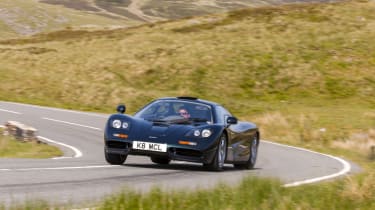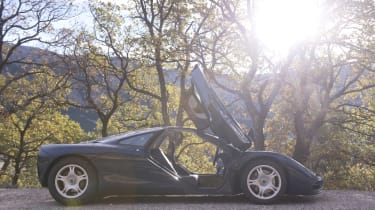The original McLaren F1 press release in full - Every detail of the incredible V12 supercar - McLaren F1 styling
As McLaren re-publishes the full, original 1992 press release for its F1 supercar, it's a perfect time to celebrate the F1, we think
ACCESS TO THE CENTRELINE DRIVING SEAT IS ASSURED BY WIDE-OPENING ‘DIHEDRAL DOORS’ INCORPORATING SECTIONS BOTH OF FLOOR AND ROOF
McLaren F1 size, style and aerodynamic targets were established upon the project’s inception, while Gordon Murray has harboured its one-plus-two seating concept since the 1960s.
Peter Stevens headed McLaren Cars’ styling studio, working with the wind tunnel team to produce hundreds of drawings and many models preceding the full-size ‘clay’. Thousands more man hours then perfected the F1’s final shape.
Its external envelope is tailored to optimum aerodynamic performance, the sophisticated ground-effect solution obviating conventional drag-inducing spoilers and wings.
The F1 requires no tail overhang to house projecting mechanical components or after-thought luggage space. These are packaged within its wheelbase, as are all major masses to minimise polar moment of inertia – and maximise inherent agility.
The F1’s nose form is far removed from the conventional deep ‘chin spoiler’. On each side, lightweight aluminium radiators are located within profiled air-ducts. Cooling air exits into the low pressure area behind each wheel arch. Between its twin air intakes, the F1’s nose swoops upward, directing airflow beneath the floor, which rises under the tail to form a downforce-generating ‘diffuser’ whose exit arches provide the only visible clue to the ground-effect aerodynamic design.
A scuttle-top air deflector ‘foil deflects raindrops and insects from the windscreen, while vents behind the headlights assist cooling when idling stationary in traffic. A discreet high-efficiency overhead intake feeds cool air to the V12 engine.
Easy access to the centreline driving seat is assured by wide-opening ‘Dihedral Doors’ incorporating sections both of floor and roof, which open in an innovative, space-saving manner.
The moulded rear windscreens provide an unobstructed view of the 48-valve V12 engine and a laminated transparent soundscreen separates engine bay from cockpit.
The tail deck is extensively louvred to release hot air from the engine and exhaust bay. Its trailing edge also houses the unique ‘Brake and Balance ‘Foil’, a crucial feature of the McLaren F1’s aerodynamic systems.




